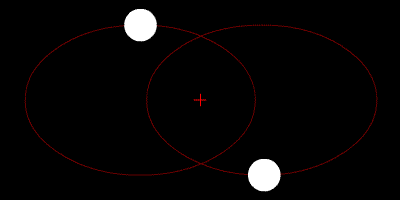Elliptic orbit

In astrodynamics or celestial mechanics an elliptic orbit is an orbit with the eccentricity greater than 0 and less than 1.
Specific energy of an elliptical orbit is negative. An orbit with an eccentricity of 0 is a circular orbit. Examples of elliptic orbits include: Hohmann transfer orbit, Molniya orbit and tundra orbit.
Velocity
Under standard assumptions the orbital speed () of a body traveling along elliptic orbit can be computed from the Vis-viva equation as:
where:
- is standard gravitational parameter,
- is radial distance of orbiting body from central body,
- is length of semi-major axis.
Conclusion:
- Velocity does not depend on eccentricity but is determined by length of semi-major axis (),
- Velocity equation is similar to that for hyperbolic trajectory with the difference that for the latter, is positive.
Orbital period
Under standard assumptions the orbital period () of a body traveling along an elliptic orbit can be computed as:
where:
- is standard gravitational parameter,
- is length of semi-major axis.
Conclusions:
- The orbital period is equal to a circular orbit with the orbit radius equal to the semi-major axis (),
- The orbital period does not depend on the eccentricity (See also: Kepler's third law).
Energy
Under standard assumptions, specific orbital energy () of elliptic orbit is negative and the orbital energy conservation equation (the Vis-viva equation) for this orbit can take the form:
where:
- is orbital speed of orbiting body,
- is radial distance of orbiting body from central body,
- is length of semi-major axis,
- is standard gravitational parameter.
Conclusions:
- Specific energy for elliptic orbits is independent of eccentricity and is determined only by semi-major axis of the ellipse.
Using the virial theorem we find:
- the time-average of the specific potential energy is equal to 2ε
- the time-average of r-1 is a-1
- the time-average of the specific kinetic energy is equal to -ε
Flight path angle
This section needs expansion. You can help by adding to it. |
Equation of motion
- See orbit equation
Orbital parameters
The state of an orbiting body at any given time is defined by the orbiting body's position and velocity with respect to the central body, which can be represented by the three-dimensional Cartesian coordinates (position of the orbiting body represented by x, y, and z) and the similar Cartesian components of the orbiting body's velocity. This set of six variables, together with time, are called the orbital state vectors. Given the masses of the two bodies they determine the full orbit. The two most general cases with these 6 degrees of freedom are the elliptic and the hyperbolic orbit. Special cases with less degrees of freedom are the circular and parabolic orbit.
Because at least six variables are absolutely required to completely represent an elliptic orbit with this set of parameters, then six variables are required to represent an orbit with any set of parameters. Another set of six parameters that are commonly used are the orbital elements.
Solar system
In the Solar System, planets, asteroids, comets and space debris have elliptical orbits around the Sun, relative to the Sun.
Moons have an elliptic orbit around their planet.
an elliptical orbit as 2 foci (fouces points)











